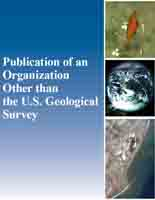
Devonian of the Southwestern United States
Links
- The Publications Warehouse does not have links to digital versions of this publication at this time
- Download citation as: RIS | Dublin Core
Abstract
The structural framework that controlled Devonian deposition consisted of, from west to east: (1) a eugeosynclinal area in northern California and western Nevada; (2) a miogeosynclinal area in southeastern California, eastern Nevada, and western Utah; and (3) a cratonic area in Arizona, eastern Utah, Colorado, New Mexico, and western Texas, east of a northeast-trending hinge line (Wasatch line).
The eugeosyncline contains a fragmentary record of Middle Devonian rocks at least 4,000 feet thick characterized by thin-bedded chert, siliceous mudstone, and some limestone and volcanic rocks. The original thickness, however, probably exceeded 6,000 feet and probably included Lower and Upper Devonian rocks. The miogeosyncline contains Lower, Middle, and Upper Devonian rocks as much as 6,000 feet thick characterized by thick units of dolomite and limestone and some local interbeds of sandstone. A transitional zone perhaps 50 miles wide separates the eugeosynclinal and miogeosynclinal facies. The craton contains mostly Upper Devonian rocks, generally less than 1,000 feet thick, characterized by dolomite and limestone and local interbeds of sandstone and mudstone.
Widespread crustal movements occurred during Late Devonian time. The Antler orogeny in Nevada initiated a culm facies in the geosyncline. Eugeosynclinal and transitional rocks including those of Devonian age were uplifted to form the Antler orogenic belt, and then were thrust eastward over autochthonous miogeosynclinal rocks in latest Devonian or earliest Mississippian time. Folding and faulting, and subsequent erosion on local uplifts, produced clastic deposits of Late Devonian age in Utah and southwestern Colorado.
Devonian rocks in many parts of the geosynclinal area have been moved since Devonian time by large-scale, generally eastward thrusting, oroflexural bending and strike-slip faulting.
Four major subdivisions of the Devonian System and related rocks are treated separately:
1) Lower Devonian (Gedinnian, Siegenian, Emsian) and related Upper Silurian (Ludlovian) rocks.
2) Middle Devonian (Eifelian and Givetian) rocks.
3) Lower Upper Devonian (Frasnian, to I) rocks.
4) Upper Upper Devonian (Famennian, to II-VI) and related lowermost Mississippian (Tournaisian, cu I) rocks.
Study Area
| Publication type | Conference Paper |
|---|---|
| Publication Subtype | Conference Paper |
| Title | Devonian of the Southwestern United States |
| Volume | I |
| Year Published | 1967 |
| Language | English |
| Publisher | Alberta Society of Petroleum Geologists |
| Publisher location | Calgary, Alberta |
| Description | 34 p. |
| Larger Work Type | Book |
| Larger Work Subtype | Conference publication |
| Larger Work Title | International symposium on the Devonian system |
| First page | 879 |
| Last page | 912 |
| Conference Title | International symposium on the Devonian system |
| Conference Location | Calgary, Alberta, Canada |
| Conference Date | 1967 |
| State | Arizona, California, Colorado, Nevada, New Mexico, Utah |
| Online Only (Y/N) | N |
| Additional Online Files (Y/N) | N |

